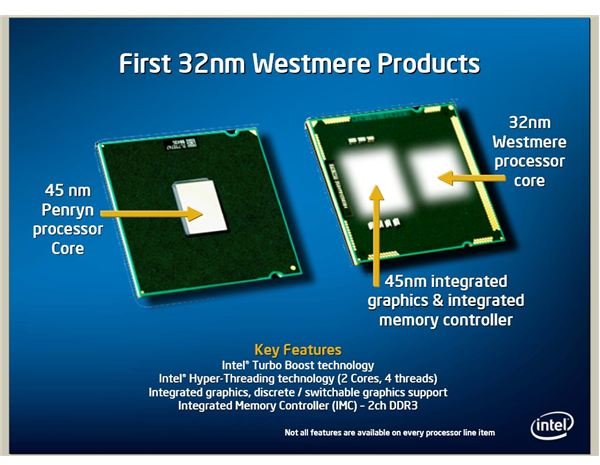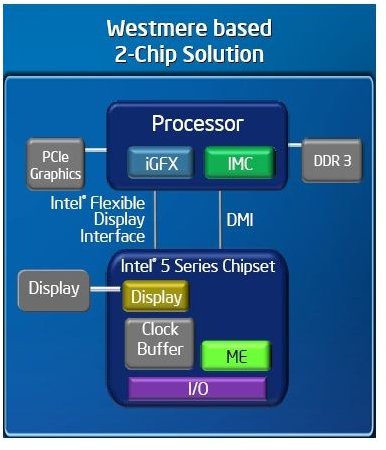Intel Can Put Graphics on a CPU: But How Good Will They Be?
That’s a Neat Trick
If you use dedicated graphics, you like to upgrade CPU and GPU separately. People who use integrated graphics, however, usually only upgrade the graphics when they replace the whole computer. Being able to upgrade graphics when they upgrade the CPU would be a plus.
Even those that don’t upgrade their CPU stand to benefit from Intel’s new processor with integrated graphics, codenamed Clarkdale, a 32nm, dual-core CPU. Moving integrated graphics (along with the memory and dedicated graphics controllers) onto the CPU has obviated the northbridge. That improves bandwidths and allows for smaller-sized systems with better power efficiency, and possibly reduces manufacturing costs, all in one go.
Display output goes from the CPU to the southbrige chipset, via Flexible Display Interface. From there it goes to an output, though we don’t know which or what combination of DVI, HDMI, or DisplayPort it will be.
We examine this northbrige-free system, used by mainstream Nehalems and called the Ibex Peak platform, here. These chipsets will come to market as the P, Q, and H Series 5.
Gift Horse Dentistry
It’s kind of lousy to deride an impressive technological innovation, in its first implementation no less, for not having top of the line performance; particularly as integrated graphics and top of the line don’t really go hand and hand. But at some time, we have to compare the tech that’s coming to the tech that’s out there, and decide which gets more bang for the buck.
The big problem with Clakrdale’s integrated graphics is that they will be based on Intel’s current, motherboard based, integrated graphics. And they are nothing to write home about, even by today’s standards.
Clarkdale Graphics: Take Aged GMA, Cook at 4500 for 45nm, Serves Small Appetite for Graphics
Basing the CPU integrated graphics on existing technology is logical. Intel is already doing something pretty new, and changing too much at once raises the odds of problems cropping up. And it’s not like Intel is taking the existing GMA 4500 integrated graphics processor and just soldering it to the Clarkdale CPU (described here).

If nothing else, there is a die shrink involved, though not all the way to 32nm. While Westmere processors will be 32nm, the graphics, and other functions that used to be done by the northbridge, will be made on a 45nm process, at least initially. The GMA 4500 is currently made on a 60nm process.
Can Next Year’s Clakdale Compete with Today’s Integrated Graphics?
Even if we assume that Intel takes advantage of the die shrink to goose the GMA 4500 processor’s clock, and the better bandwidth from having it on the CPU, that may not be good enough. Intel’s GMA 4500 hundred, at present, is really the lame duck of integrated graphics.
AMD’s 780G chipset totally changed what people expect from integrated graphics. On the Intel motherboard side, it was Nvidia that saved the day with the comparable 9300 and slightly nicer 9400 chipsets. The only people getting by on GMA 4500 should be office users.
The thing can barely handle home-theatre PC duties, and forget about gaming. The AMD and Nvidia chipsets can even handle games… if you turn the settings down far enough and the moon is full.
Blue Team fans may have hoped the Green Team would pull them out of the fire again, perhaps finding a way to include 9400 type graphics on an Ibex Peak compatible chipset. But Intel is having none of it, and are dragging Nvidia into court to stop them from making chipsets for Nehalem under their existing agreements.
Nothing Special at First, But Is Larrabe Coming?
Intel can be forgiven for hedging their radical, new, CPU with integrated graphics technology by hooking it to the time tested GMA 4500, in theory. In practice, it won’t be enough to call for an upgrade, at least in this economy. There is no reason future implementations of the technology, however, won’t be more tempting.
It would be particularly exciting to see how Intel’s project to create a dedicated, multi-core graphics solution, called Larrabee, will pan out, and if we will ever see it in an integrated package.
